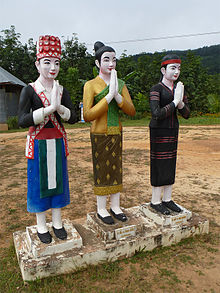Lao Soung

The Lao Soung ( Lao ລາວ ສູງ , ALA-LC : lāo sūng , pronunciation: [láːw sǔːŋ] , "highland Laotians" or "Laotians of the mountain peaks") are one of the three government-defined categories of the population of Laos . These are not primarily defined ethnically, but rather topographically according to the habitat. Lao Sung includes the peoples who typically settle in the mountains and plateaus of north and north-east Laos and the province of Xieng Khouang at altitudes of over 1000 meters above sea level. With 11.5% (as of 2005) they represent the smallest of the three main groups of the population of Laos. The Lao Soung are made up of 48 ethnic groups, including the Hmong , Iu Mien ( Yao ), Phunoi and Lahu . The members of the peoples concerned themselves do not use the Lao Soung category .
The classification implicitly goes hand in hand with differences in language, settlement history and traditional way of life. The Lao Soung speak Hmong-Mien and Tibetan Burman languages . They immigrated from southern China to what is now Laos in the 19th and 20th centuries . They typically practice slash-and- burn agriculture and live mainly from cattle breeding and corn cultivation. A minority produces opium . In 2005 the state government announced the elimination of opium cultivation. In 2007 the Federal Ministry for Economic Cooperation and Development found that the area under cultivation had become so small that there was no longer any opium export from Laos. Lao Soung mainly practice animistic religions , a minority have converted to Christianity (especially Hmong).
Due to the inaccessible settlement area of the Lao Soung and the different ways of life, there was initially little contact with the Tai-speaking population of the lowlands and the river valleys ( Lao Loum ). That changed after Laos gained independence from France and during the Lao Civil War (1953–1975). The pro-communist rebels of the Pathet Lao recruited members of the Lao Soung for their revolutionary liberation struggle and recognized them - alongside Lao Loum and Lao Theung - as part of the Lao nation with equal rights. On the other hand, some of the Hmong fought under their leader General Vang Pao in a "secret army" raised by the CIA on the side of the USA . After the end of the war, the communist government persecuted the Hmong as alleged traitors. Many of them fled to Thailand , the US, Australia , Germany and France .
swell
- ^ Werner Wilbert (1991): Thailand - Laos . In: Jens Siegelberg (ed.): The wars 1985 to 1990: Analysis of their causes . LIT publishing house. Pages 410-417. ISBN 3-88660-757-7 page 412
- ↑ Jan Ovesen: All Lao? Minorities in the Lao People's Democratic Republic. In: Christopher R. Duncan: Civilizing the Margins. Southeast Asian Government Policies for the Development of Minorities. NUS Press, Singapore 2008, p. 216.
- ↑ Martin Stuart-Fox : Historical Dictionary of Laos. 3rd edition, Scarecrow Press, Lanham (MD) / Plymouth 2008, p. 191, entry Lao Soung .
- ↑ Christian Postert: Completing or Competing? Contexts of Hmong Selfing / Othering in Laos . In: Gerd Baumann, André Gingrich (Eds.): Grammars of Identity / alterity: A Structural Approach . Berghahn Books, 2004, ISBN 1-57181-698-4 , pp. 101–111, here p. 104. Page 104
- ↑ Laos, Perspectives for Generations ( Memento of the original from June 10, 2015 in the Internet Archive ) Info: The archive link was inserted automatically and has not yet been checked. Please check the original and archive link according to the instructions and then remove this notice. , Federal Ministry for Economic Cooperation and Development (PDF file; 374 kB), accessed on November 20, 2013.
- ↑ Jan Ovesen: All Lao? Minorities in the Lao People's Democratic Republic. In: Christopher R. Duncan: Civilizing the Margins. Southeast Asian Government Policies for the Development of Minorities. NUS Press, Singapore 2008, p. 225.
- ↑ Martin Stuart-Fox : Historical Dictionary of Laos. 3rd edition, Scarecrow Press, Lanham (MD) / Plymouth 2008, p. 58, entry Christianity .
- ↑ Jan Ovesen: All Lao? Minorities in the Lao People's Democratic Republic. In: Christopher R. Duncan: Civilizing the Margins. Southeast Asian Government Policies for the Development of Minorities. NUS Press, Singapore 2008, pp. 221, 237.
- ↑ Annegret Meiners (2005): The Forgotten Army: Rebels are no longer a threat for a long time ( memento of the original from April 29, 2010 in the Internet Archive ) Info: The archive link was automatically inserted and not yet checked. Please check the original and archive link according to the instructions and then remove this notice. at amnesty-seamran.de, accessed on November 20, 2013.